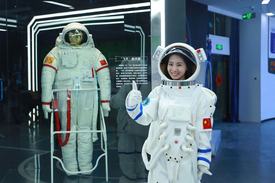
Photo: Chen Kun
A tourist in a space suit at the Aerospace Science and Technology Experiment Center in 1969 in Jiuquan, Gansu Province.
Liu Yang (Liu Yang) flew into space for the first time in 2012, aboard the 9-person Shenzhou spacecraft. When he returned home and left Tiankong-1, he vowed that one day he would return to the site of his research, the universe. Ten years later, he and his colleagues accompanied the arrival of the Ventien and Mengtien (Dream of the Sky) space capsules aboard the Shenzhou-14 ship. At that time, China had already built its own space station called Tienkung (Heavenly Palace), whose core module known as Tienho (Heavenly Harmony) was launched at the end of April 2021. The works were completed in twenty months, making China the owner of World record in this field as well. Chinese space technology has caught up with the developed world in the blink of an eye, even though its competitors have been outpacing this specialized sector of science for decades.
In terms of developing key technologies and tools, China's goal was clearly to be able to create all the conditions on its own. The efforts were not in vain. The Chinese space station is now a facility with more than one hundred cubic meters of working and living space, which, based on its technical standards, is at the forefront of space research. In the Space Science Laboratory of China Space Home, experiments are being carried out continuously, thanks to which results can be used in more and more fields. By August 2023, the Chinese Space Station has implemented more than a hundred scientific research and applied projects, thanks to which more than 4,000 innovations have been created, the application of which will cover all areas of life. Behind this success lies the joint effort of more than 110 scientific research institutes, more than 3,000 scientific research units, and hundreds of thousands of scientific researchers.
In addition to medical science, space research and navigation developments, scientific work also covers agricultural experiments. The crew members of Shenzhou-11, which was launched in 2016, with the help of astronauts Jing Haiping and Chen Dong, planted vegetables for the first time in space. The researchers were thrilled when they saw the success of the germination process. Six years later, when Chinese astronauts celebrated the Mid-Autumn Festival in space for the first time, they could actually eat fresh, homemade salad with the festive feast. “It tastes very delicious,” astronaut Cai Xiuzhi laughed after the first taste. Although his words were trivial, they belong to the most beautiful chapters in the history of space exploration.
With the construction of the Pejtou (Beidou) network – China's Global Positioning System (GPS) – the results of the Chang'e lunar exploration program, the successful landing of the Tianwen Mars rover and the Xihe solar research satellite prove that China's aviation and space exploration reach will be deeper and broader. Chinese astronauts are the heroes of the most beautiful chapters in the history of science, and humanity's dreams of exploring the universe have become part of the Chinese dream. In order to achieve this goal, the working conditions of researchers working on the space station are constantly improving. Astronaut Ni Haisheng has visited space three times, and according to him, he gets new feelings and experiences from the National Space Station every time:
“It has become more comfortable and safer,” he said upon his return from his space journey, “and the food has become better as well, and through all this, the size of the search rooms has become much larger.”
“After entering the space station, I noticed that the sleeping area had become almost completely silent, while also serving as a real observation point for us. While resting, I use my phone to take pictures of outer space behind the window. “It's an incredible feeling, and I feel incredibly proud to be able to serve at our nation's number one space research base.”

The writer is a journalist at the People's Daily






